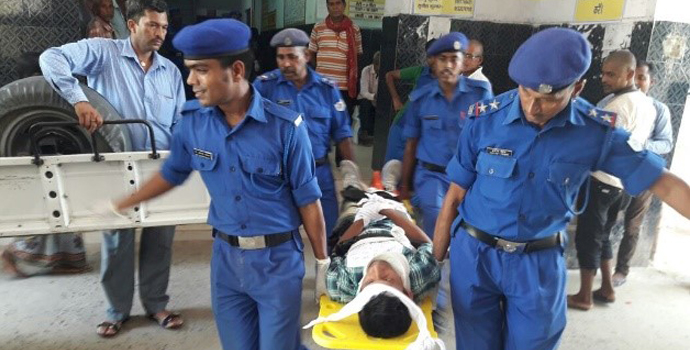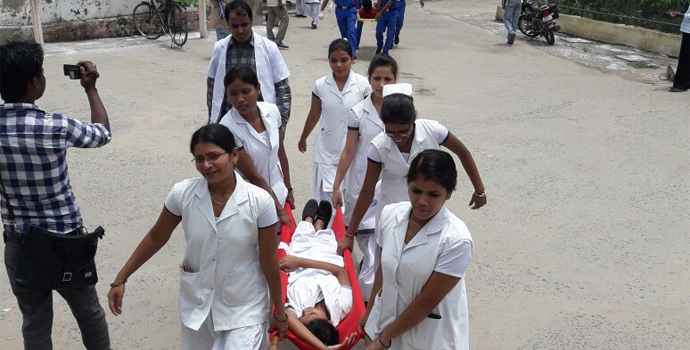- About Us
-
Who we are
-
- Publications
-
- ADPC Academy
-
MediaADPC'S NEWS
PROSPER - India: from building emergency response capacity to strengthening institutional capacity for disaster preparedness PROSPER - India: from building emergency response capacity to strengthening institutional capacity for disaster preparedness
30 Oct 2018
Bihar, India

Hospital staff participating in mock drills as part of the initiative to strengthen the emergency response capacity of Bihar
Building upon the experiences and lessons from the initial program on “Applying Bihar Recommendations: Building State-Level Emergency Response Capacity,” with extended support from the Bill & Melinda Gates Foundation (BMGF), ADPC continues to assist the government of Bihar in the implementation of Bihar Disaster Risk Reduction Roadmap (2015 – 2030). The ‘Program for Strengthening Preparedness for Emergency Response and Recovery in India’ (PROSPER-India), with support from the Bill & Melinda Gates Foundation, will actively build upon the recommendations of the National Disaster Management policy and plan for mainstreaming DRR, while continuing to assist the government of Bihar with select priority activities towards the Bihar DRR Roadmap.
The previous phase (2015 – 18) focused on providing technical assistance to the government of Bihar through development of tools and systems for assessing and communicating disaster risk for health and agriculture sectors. The program also assisted the government in developing well defined policy instruments such as: ‘Meghdoot’ a new scheme for hydro-meteorological early warning for farmers; Hospital Disaster Management Plans for pilot districts; and Standard Operating Procedure and Operational Guidelines for management of mass casualty. The current Agriculture Roadmap of the government of Bihar (2017 – 22) developed with assistance from the program, also includes a dedicated section on reducing disaster and climate risk.
Multi-stakeholder based Emergency Management Exercises (EMEx), in pilot district hospitals, were implemented to transfer knowledge and skills on preparing for well-coordinated response during emergencies. Participants included: hospital staff, ambulance and fire services, police, red-cross and other volunteers, alongside state disaster response force personnel.
Based on a systematic training need assessment conducted by the program, trainers from the department of health, agriculture and disaster management, have been developed to impart further training on various aspects of disaster management. Key focus areas include: promotion of family emergency preparedness by Accredited Social Health Activists (ASHA), Development of District Hospital Emergency Response Plans, mainstreaming DRR in Agriculture and Disaster Management sectors, climate change adaptation and sustainable livelihoods and the role of Panchayati Raj institutions in disaster risk management. These activities are estimated to have benefitted 256,000 individuals across 3 districts.

Participants carrying out mock drills at a district hospital in Nalanda
To strengthen emergency response capacity within the state, the Disaster Management department initiated the set-up of a state-of-the-art Emergency Operations Centre (EOC). In the interim, the program assisted the department of disaster management to develop and host SAMBAL - Surakshit Bihar kaLakshya (aiming for a safer Bihar) – a virtual knowledge center to promote knowledge sharing among policy makers and practitioners for implementation of the Bihar DRR Roadmap.
Through experiences and lessons learnt from the initial phase, the program has been expanded beyond the original sectoral focus of health, agriculture and disaster management in Bihar. The program will move towards incorporating private sector players and implementing a selected flagship program for mainstreaming disaster risk management.
The lessons of the first phase of the program have been crucial in developing the current phase that reaches out to additional sectors, stakeholders and geographies within Bihar and in the country as a whole.
With over 58.6 per cent of the Indian landmass prone to earthquakes of moderate to very high intensity, over 40 million hectares (12%) of land is prone to floods and river erosion; and over 5,700 km of its coastline is prone to cyclones and tsunamis. In addition, 68% of its cultivable area is vulnerable to droughts that are further exacerbated due to the changing climate. Bihar has faced similar calamities, with over half of the state prone to earthquakes and floods and a significant part of the south prone to droughts. It is thus hoped that the technical assistance provided by the program would help in strengthening emergency preparedness in Bihar and India as a whole.
Latest NewsRelated Trainings
-